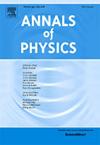Stable f(Q) gravity model through non-trivial connection
IF 3
3区 物理与天体物理
Q2 PHYSICS, MULTIDISCIPLINARY
引用次数: 0
Abstract
This study effectively reconstructs a cosmological model utilizing covariant gravity within Connection-III and FLRW spacetime. The dynamic behavior of the reconstructed model is thoroughly analyzed using the Hubble parameter and various observational datasets. Our robust findings demonstrate that the model displays quintessence behavior at the present epoch and converges to the CDM model at late time. It is confirmed through comprehensive evaluations against energy conditions that the Null Energy Condition remains positive throughout cosmic evolution, and the Dominant Energy Condition is consistently satisfied. The Strong Energy Condition is initially fulfilled in the early Universe but violated in the late epoch. Moreover, scalar perturbations extensively assess stability, affirming the strength of the model with respect to the Hubble parameter. This research offers compelling insights into cosmic acceleration, suggesting that gravity can effectively displace the CDM model and provides a convincing alternative explanation for the current accelerating expansion of the Universe without relying on the cosmological constant.
求助全文
约1分钟内获得全文
求助全文
来源期刊

Annals of Physics
物理-物理:综合
CiteScore
5.30
自引率
3.30%
发文量
211
审稿时长
47 days
期刊介绍:
Annals of Physics presents original work in all areas of basic theoretic physics research. Ideas are developed and fully explored, and thorough treatment is given to first principles and ultimate applications. Annals of Physics emphasizes clarity and intelligibility in the articles it publishes, thus making them as accessible as possible. Readers familiar with recent developments in the field are provided with sufficient detail and background to follow the arguments and understand their significance.
The Editors of the journal cover all fields of theoretical physics. Articles published in the journal are typically longer than 20 pages.
 求助内容:
求助内容: 应助结果提醒方式:
应助结果提醒方式:


